Numerical Study of the Flow and Blockage Ratio of Cylindrical Pier Local Scour
Abstract
:1. Introduction
- (i)
- General scour, which occurs irrespective of the presence of an obstacle.
- (ii)
- Contraction scour, which occurs as a result of constriction due to lateral groins, spur dikes, or bridge abutments.
- (iii)
- Local scour, which is only observed at the base of the obstacle and does not lead to sediment transport far from the pier.
2. Mathematical Model
2.1. Hydrodynamic Model
2.2. Morphodynamic Model
2.3. Sand-Slide Model for the Sediment Bed
2.4. Narrow Channel Boundary Conditions
3. Numerical Method
3.1. Configurations of the Computational Domain
3.2. Initial and Boundary Conditions
4. Numerical Results
4.1. Live-Bed and Wide Channel Case
4.2. Clear-Water Case
4.2.1. Hydrodynamic Validation
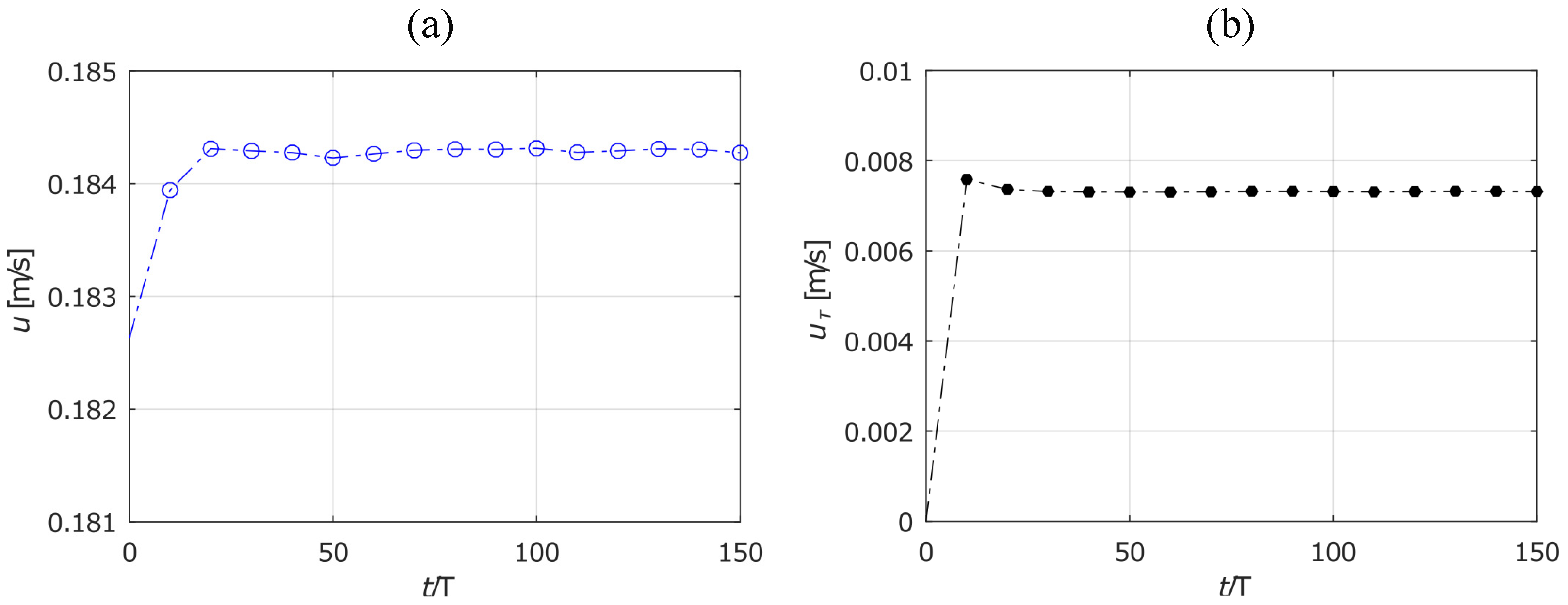
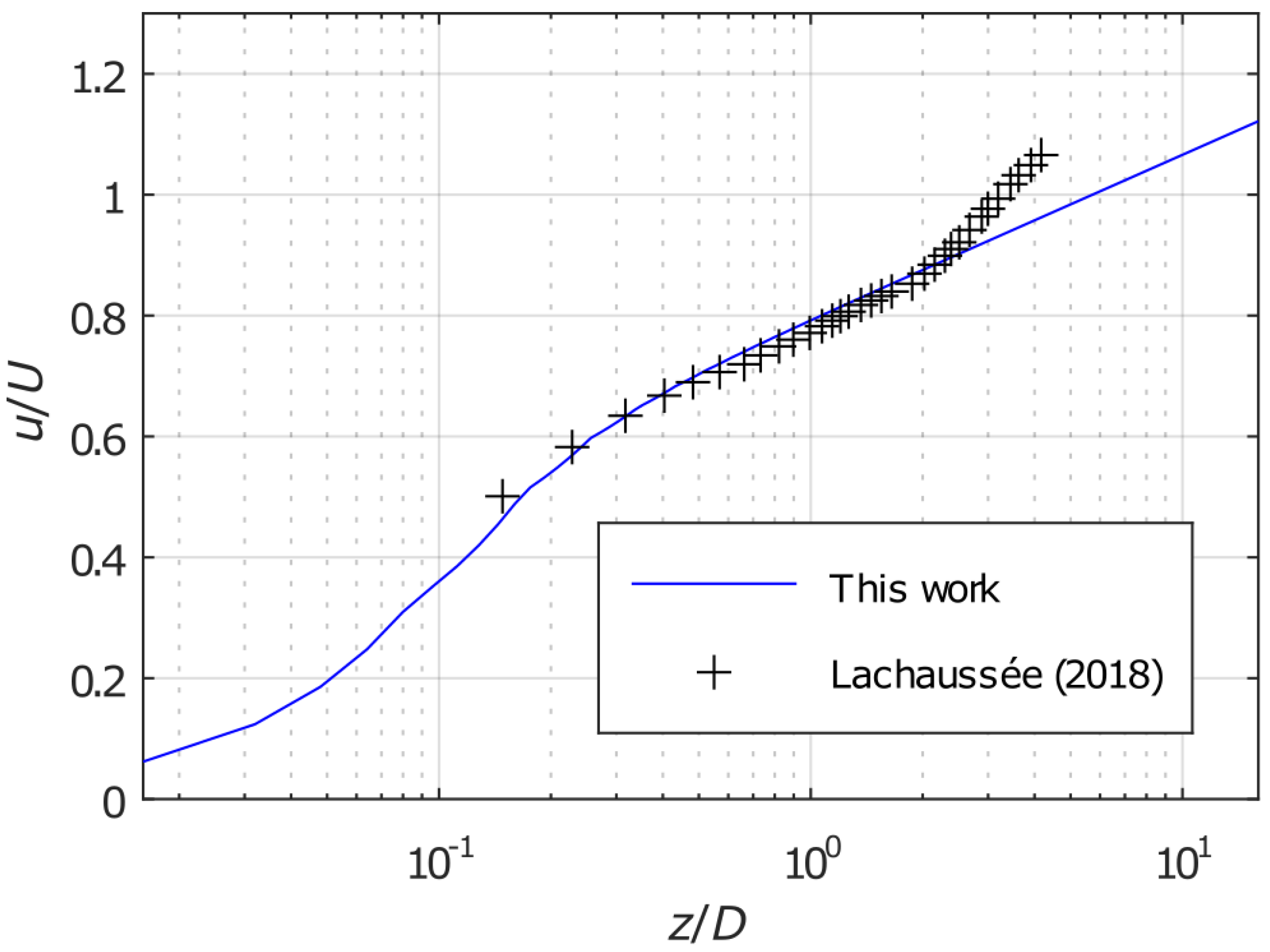
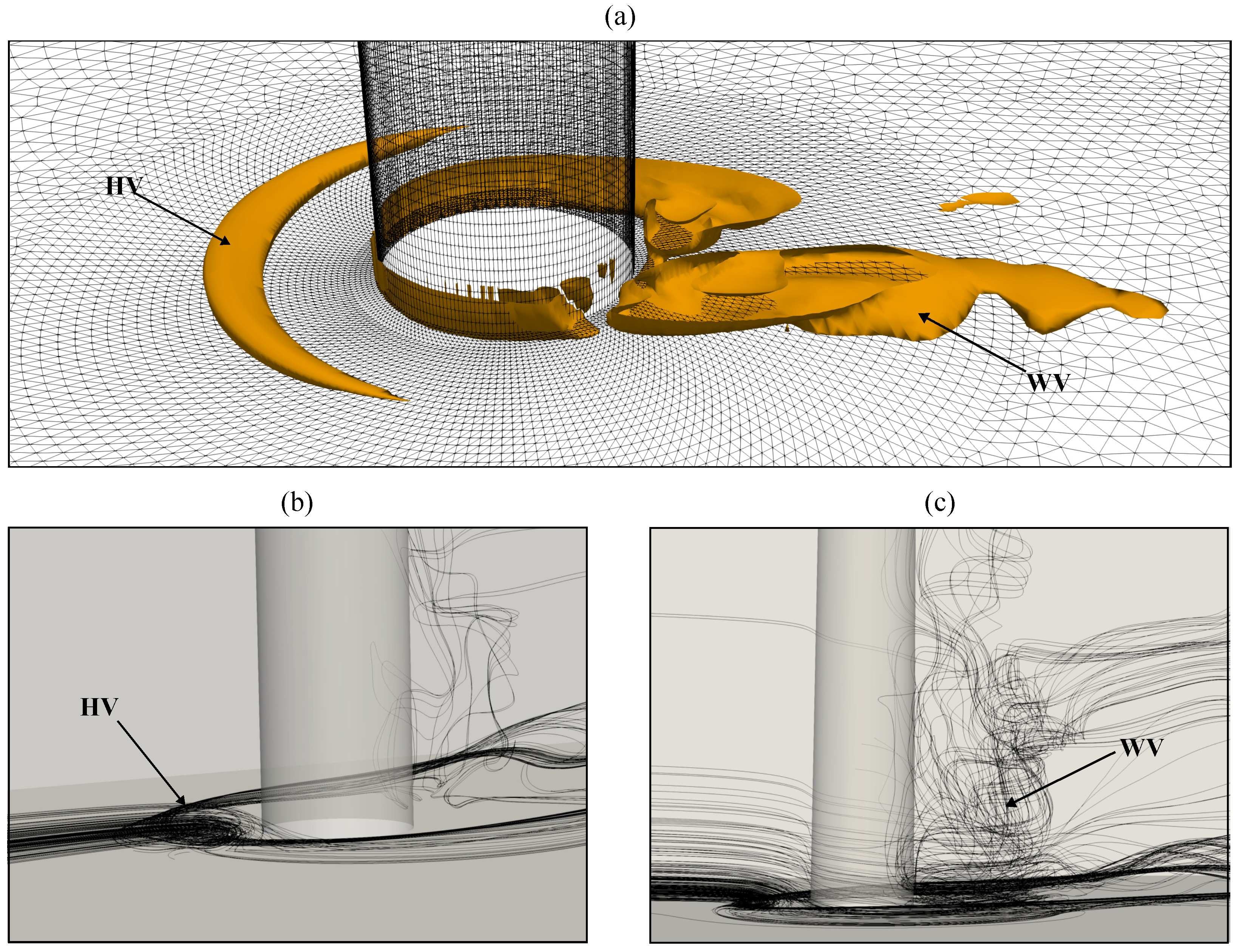

4.2.2. Morphodynamic Validation
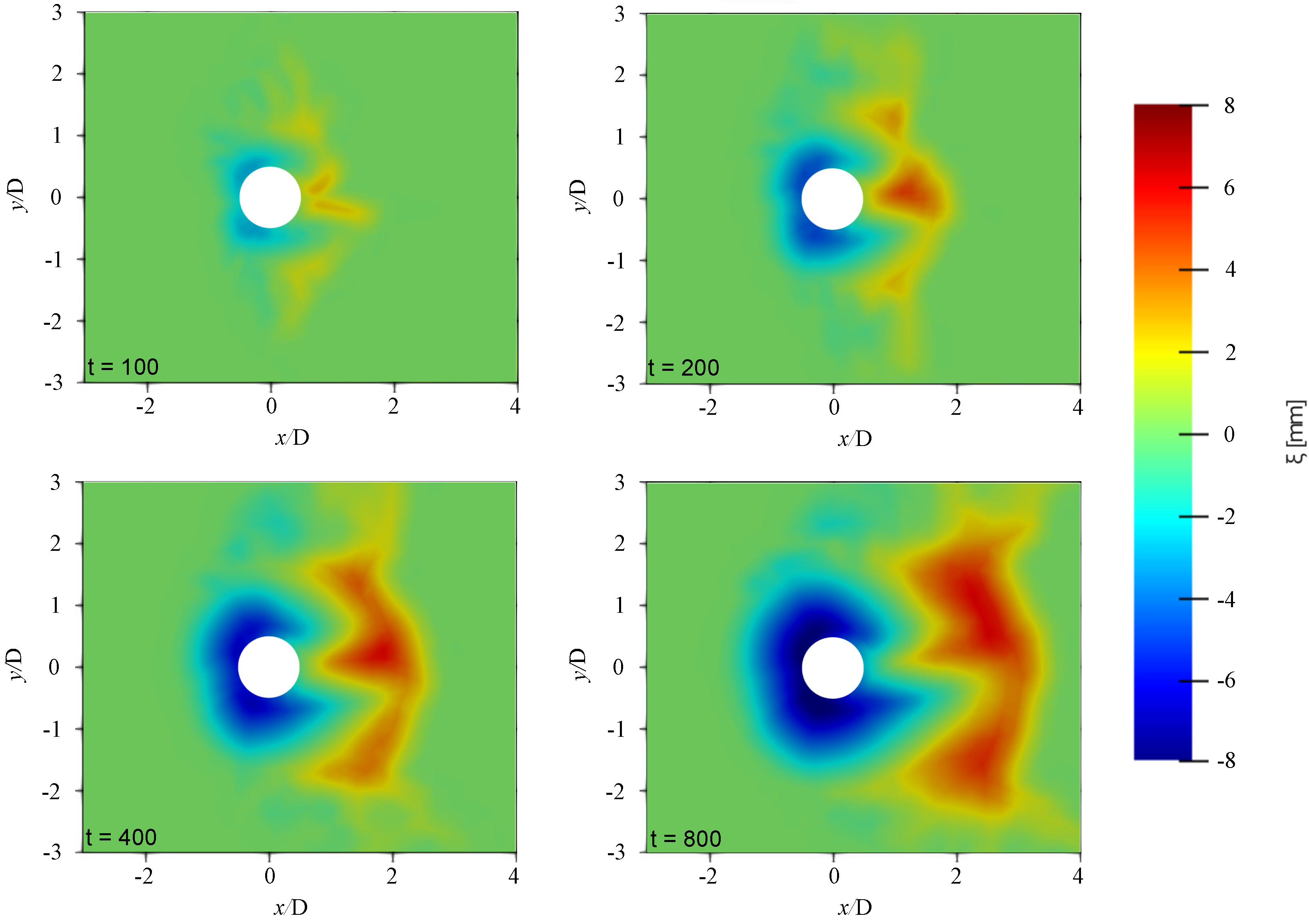


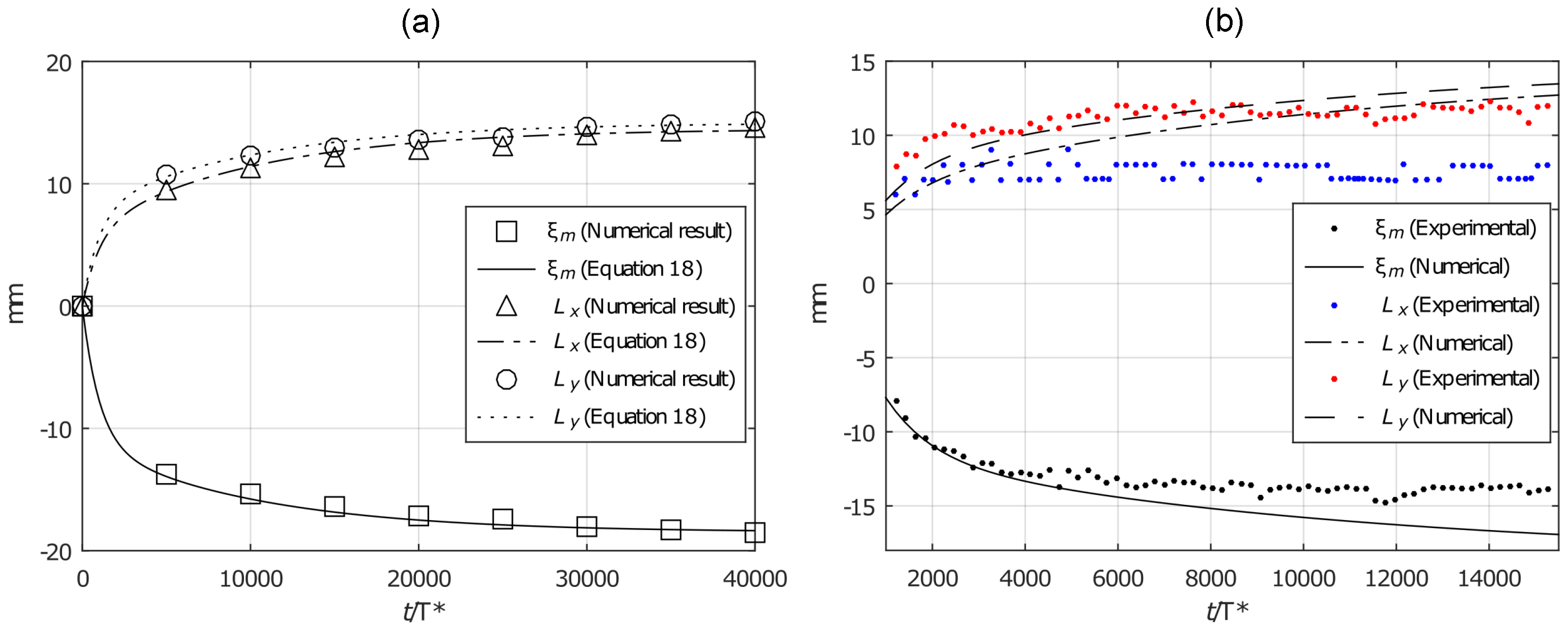

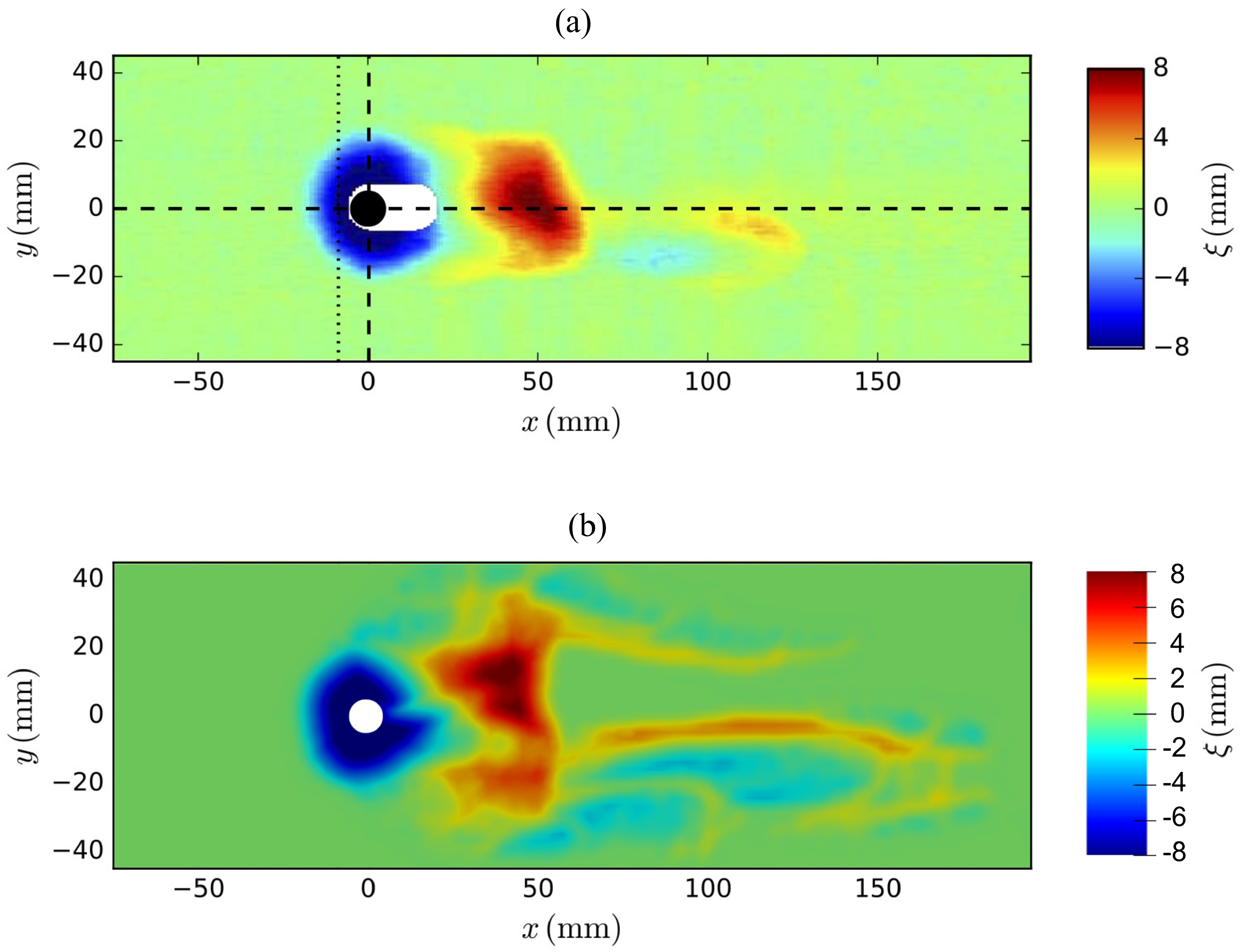

4.3. Effects of the Channel Width on the Clear-Water Local Scour Pattern
5. Conclusions
Author Contributions
Funding
Institutional Review Board Statement
Informed Consent Statement
Data Availability Statement
Acknowledgments
Conflicts of Interest
References
- Raudkivi, A.; Ettema, R. Clear-water scour at cylindrical piers. J. Hydraul. Eng. 1983, 109, 338–350. [Google Scholar] [CrossRef]
- Melville, B.W.; Chiew, Y.M. Time scale for local scour at bridge piers. J. Hydraul. Eng. 1999, 125, 59–65. [Google Scholar] [CrossRef]
- Ettema, R.; Constantinescu, G.; Melville, B.W. Flow-field complexity and design estimation of pier-scour depth: Sixty years since Laursen and Toch. J. Hydraul. Eng. 2017, 143, 03117006. [Google Scholar] [CrossRef]
- Roulund, A.; Sumer, B.M.; Fredsøe, J.; Michelsen, J. Numerical and experimental investigation of flow and scour around a circular pile. J. Fluid Mech. 2005, 534, 351–401. [Google Scholar] [CrossRef]
- Stevens, M.A.; Gasser, M.M.; Saad, M.B.A.M. Wake Vortex Scour at Bridge Piers. J. Hydraul. Eng. 1991, 117, 891–904. [Google Scholar] [CrossRef]
- Williams, P.; Bolisetti, T.; Balachandar, R. Blockage correction for pier scour experiments. Can. J. Civ. Eng. 2018, 45, 413–417. [Google Scholar] [CrossRef]
- Proske, D. Bridge Collapse Frequencies versus Failure Probabilities; Springer: Berlin, Germany, 2018. [Google Scholar]
- Arneson, L.; Zevenbergen, L.; Lagasse, P.; Clopper, P. Evaluating Scour at Bridges; Technical Report; Federal Highway Administration: Fort Collins, CO, USA, 2012.
- Huber, F. Update: Bridge scour. ASCE 1991, 61, 62–63. [Google Scholar]
- Wardhana, K.; Hadipriono, F.C. Analysis of recent bridge failures in the United States. J. Perform. Constr. Facil. 2003, 17, 144–150. [Google Scholar] [CrossRef]
- Lin, C.; Han, J.; Bennett, C.; Parsons, R.L. Case history analysis of bridge failures due to scour. In Climatic Effects on Pavement and Geotechnical Infrastructure; American Society of Civil Engineers: Reston, VA, USA, 2014; pp. 204–216. [Google Scholar] [CrossRef]
- Taricska, M. An Analysis of Recent Bridge Failures (2000–2012). Master’s Thesis, Ohio State University, Columbus, OH, USA, 2014. [Google Scholar]
- Kirkil, G.; Constantinescu, G. Nature of flow and turbulence structure around an in-stream vertical plate in a shallow channel and the implications for sediment erosion. Water Resour. Res. 2009, 45, W06412. [Google Scholar] [CrossRef]
- Kirkil, G.; Constantinescu, G. A numerical study of the laminar necklace vortex system and its effect on the wake for a circular cylinder. Phys. Fluids 2012, 24, 073602. [Google Scholar] [CrossRef]
- Kirkil, G.; Constantinescu, G. Effects of cylinder Reynolds number on the turbulent horseshoe vortex system and near wake of a surface-mounted circular cylinder. Phys. Fluids 2015, 27, 075102. [Google Scholar] [CrossRef]
- Lachaussée, F.; Bertho, Y.; Morize, C.; Sauret, A.; Gondret, P. Competitive dynamics of two erosion patterns around a cylinder. Phys. Rev. Fluids 2018, 3, 012302. [Google Scholar] [CrossRef]
- Lai, Y.G.; Liu, X.; Bombardelli, F.A.; Song, Y. Three-Dimensional Numerical Modeling of Local Scour: A State-of-the-Art Review and Perspective. J. Hydraul. Eng. 2022, 148, 03122002. [Google Scholar] [CrossRef]
- Lachaussée, F. Érosion et Transport de Particules au Voisinage d’un Obstacle (in French). Ph.D. Thesis, Université Paris-Saclay, Paris, France, 2018. Available online: https://www.theses.fr/2018SACLS377 (accessed on 24 July 2023).
- Zhang, W.; Uh Zapata, M.; Pham Van Bang, D.; Nguyen, K.D. Three-Dimensional Hydrostatic Curved Channel Flow Simulations Using Non-Staggered Triangular Grids. Water 2022, 14, 174. [Google Scholar] [CrossRef]
- Zhang, W.; Uh Zapata, M.; Bai, X.; Pham Van Bang, D.; Nguyen, K.D. Three-dimensional simulation of horseshoe vortex and local scour around a vertical cylinder using an unstructured finite-volume technique. Int. J. Sediment Res. 2020, 35, 295–306. [Google Scholar] [CrossRef]
- Yu, P.; Zhu, L. Numerical simulation of local scour around bridge piers using novel inlet turbulent boundary conditions. Ocean Eng. 2020, 218, 108166. [Google Scholar] [CrossRef]
- Jia, Y.; Altinakar, M.; Guney, S. Three-dimensional numerical simulations of local scouring around bridge piers. J. Hydraul. Res. 2017, 56, 351–366. [Google Scholar] [CrossRef]
- Xiong, W.; Tang, P.; Kong, B. Computational Simulation of Live-Bed Bridge Scour Considering Suspended Sediment Loads. J. Comput. Civ. Eng. 2017, 31, 04017040. [Google Scholar] [CrossRef]
- Baykal, C.; Sumer, B.M.; Fuhrman, D.R.; Jacobsen, N.G.; Fredsøe, J. Numerical investigation of flow and scour around a vertical circular cylinder. Phil. Trans. R. Soc. A 2015, 373, 104. [Google Scholar] [CrossRef]
- Baykal, C.; Sumer, B.M.; Fuhrman, D.R.; Jacobsen, N.G.; Fredsøe, J. Numerical simulation of scour and backfilling processes around a circular pile in waves. Coast. Eng. 2017, 122, 87–107. [Google Scholar] [CrossRef]
- Olsen, N.; Melaaen, C. Three-dimensional calculation of scour around cylinders. J. Hydraul. Mech. 1993, 119, 1048–1054. [Google Scholar] [CrossRef]
- Zhao, M.; Cheng, L.; Zang, Z. Experimental and numerical investigation of local scour around a submerged vertical circular cylinder in steady currents. Coast. Eng. 2010, 57, 709–721. [Google Scholar] [CrossRef]
- Khosronejad, A.; Flora, K.; Sotiropoulos, F. Experimental and computational investigation of local scour around bridge piers. Water Resour. 2012, 37, 73–85. [Google Scholar] [CrossRef]
- Link, O.; González, C.; Maldonado, M.; Escauriaza, C. Coherent structure dynamics and sediment particle motion around a cylindrical pier in developing scour hole. Acta Geophys. 2012, 60, 1689–1719. [Google Scholar] [CrossRef]
- Van Rijn, L.C. Principles of Sediment Transport in Rivers, Estuaries And Coastal Seas; Aqua Publications: Amsterdam, The Netherlands, 1993. [Google Scholar]
- Zhang, W. 3D Numerical Simulation of Scour Erosion Around an Obstacle. Ph.D. Thesis, Université Paris-Est, Paris, France, 2019. [Google Scholar]
- Chen, J.H.; Pritchard, W.G.; Tavener, S.J. Bifurcation for flow past a cylinder between parallel planes. J. Fluid Mech. 1995, 284, 23–41. [Google Scholar] [CrossRef]
- Singha, S.; Sinhamahapatra, K.P. Flow past a circular cylinder between parallel walls at low Reynolds numbers. Ocean Eng. 2010, 37, 757–769. [Google Scholar] [CrossRef]
- Mignot, E.; Moyne, T.; Doppler, D.; Riviere, N. Clear-Water Scouring Process in a Flow in Supercritical Regime. J. Hydraul. Eng. 2015, 142, 04015063. [Google Scholar] [CrossRef]
- Engelund, F.; Fredsøe, J. A sediment transport model for straight alluvial channels. Hydrol. Res. 1976, 7, 293–306. [Google Scholar] [CrossRef]
- Bento, A.M.; Pêgo, J.P.; Viseu, T.; Couto, L. Scour Development Around an Oblong Bridge Pier: A Numerical and Experimental Study. Water 2023, 15, 2867. [Google Scholar] [CrossRef]
- Mason, P.J.; Thomson, D.J. Stochastic backscatter in large-eddy simulations of boundary layers. J. Fluid Mech. 1992, 242, 51. [Google Scholar] [CrossRef]
- Nikuradse, J. Laws of Flow in Rough Pipes; Technical Memorandum 1292; National Advisory Committee for Aeronautics: Washington, DC, USA, 1950.
- Roulsby, R. Dynamics of Marine Sands: A Manual for Practical Applications; Thomas Telford: London, UK, 1997. [Google Scholar]
- Swamee, P.K. Generalized inner region velocity distribution equation. J. Hydraul. Eng. 1993, 119, 651–656. [Google Scholar] [CrossRef]
- Uh Zapata, M.; Pham Van Bang, D.; Nguyen, K.D. An unstructured finite volume technique for the 3D Poisson equation on arbitrary geometry using a sigma-coordinate system. Int. J. Numer. Methods Fluids 2014, 76, 611–631. [Google Scholar] [CrossRef]
- Uh Zapata, M.; Pham Van Bang, D.; Nguyen, K.D. Unstructured Finite-Volume Model of Sediment Scouring Due to Wave Impact on Vertical Seawalls. J. Mar. Sci. Eng. 2021, 9, 1440. [Google Scholar] [CrossRef]
- Phillips, N.A. A coordinate system having some special advantages for numerical forecasting. J. Meteor. 1957, 14, 184–185. [Google Scholar] [CrossRef]
- Chorin, A.J. Numerical solution of the Navier-Stokes equations. Math. Comput. 1968, 22, 745–762. [Google Scholar] [CrossRef]
- Uh Zapata, M.; Zhang, W.; Pham Van Bang, D.; Nguyen, K.D. A parallel second-order unstructured finite volume method for 3D free-surface flows using a σ coordinate. Comput. Fluids 2019, 190, 15–29. [Google Scholar] [CrossRef]
- Sumer, B.; Fredsøe, J.; Christiansen, N. Scour around vertical pile in waves. J. Waterw. Port Coast. Ocean Eng. 1992, 118, 15–31. [Google Scholar] [CrossRef]
- Baker, C.J. The laminar horseshoe vortex. J. Fluid Mech. 1979, 95, 347–367. [Google Scholar] [CrossRef]
- Kothyari, U.; HAger, W.H.; Oliveto, G. Generalized approach for clear-water scour at bridge foundation elements. J. Hydraul. Eng. 2007, 133, 1229–1240. [Google Scholar] [CrossRef]
- Tejada, S. Effects of Blockage and Relative Coarseness on Clear Water Bridge Pier Scour. Master’s Thesis, University of Windsor, Windsor, ON, Canada, 2014. Available online: https://scholar.uwindsor.ca/etd/5055/ (accessed on 24 July 2023).
- Harasti, A.; Gilja, G.; Adžaga, N.; Žic, M. Analysis of Variables Influencing Scour on Large Sand-Bed Rivers Conducted Using Field Data. Appl. Sci. 2023, 13, 5365. [Google Scholar] [CrossRef]
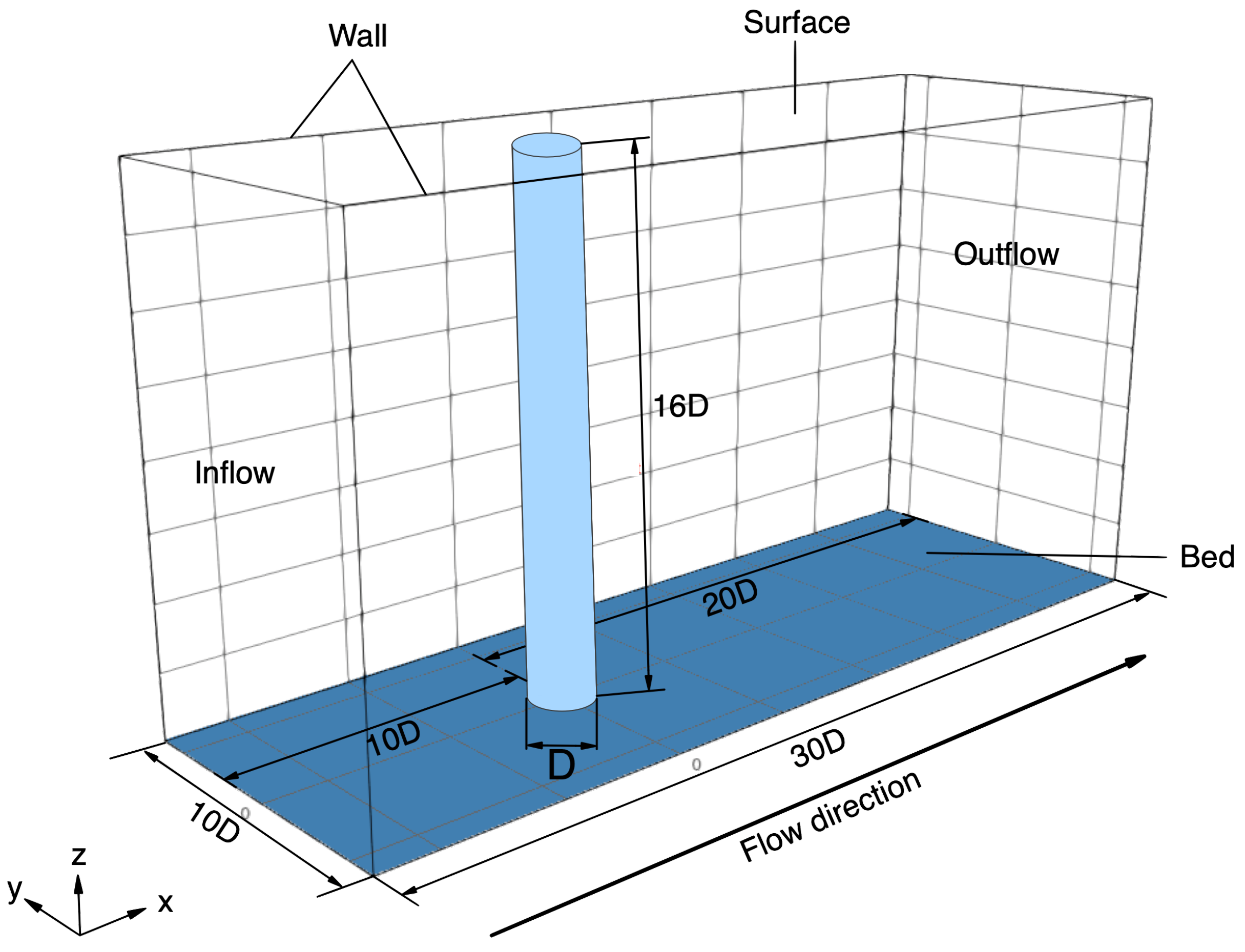

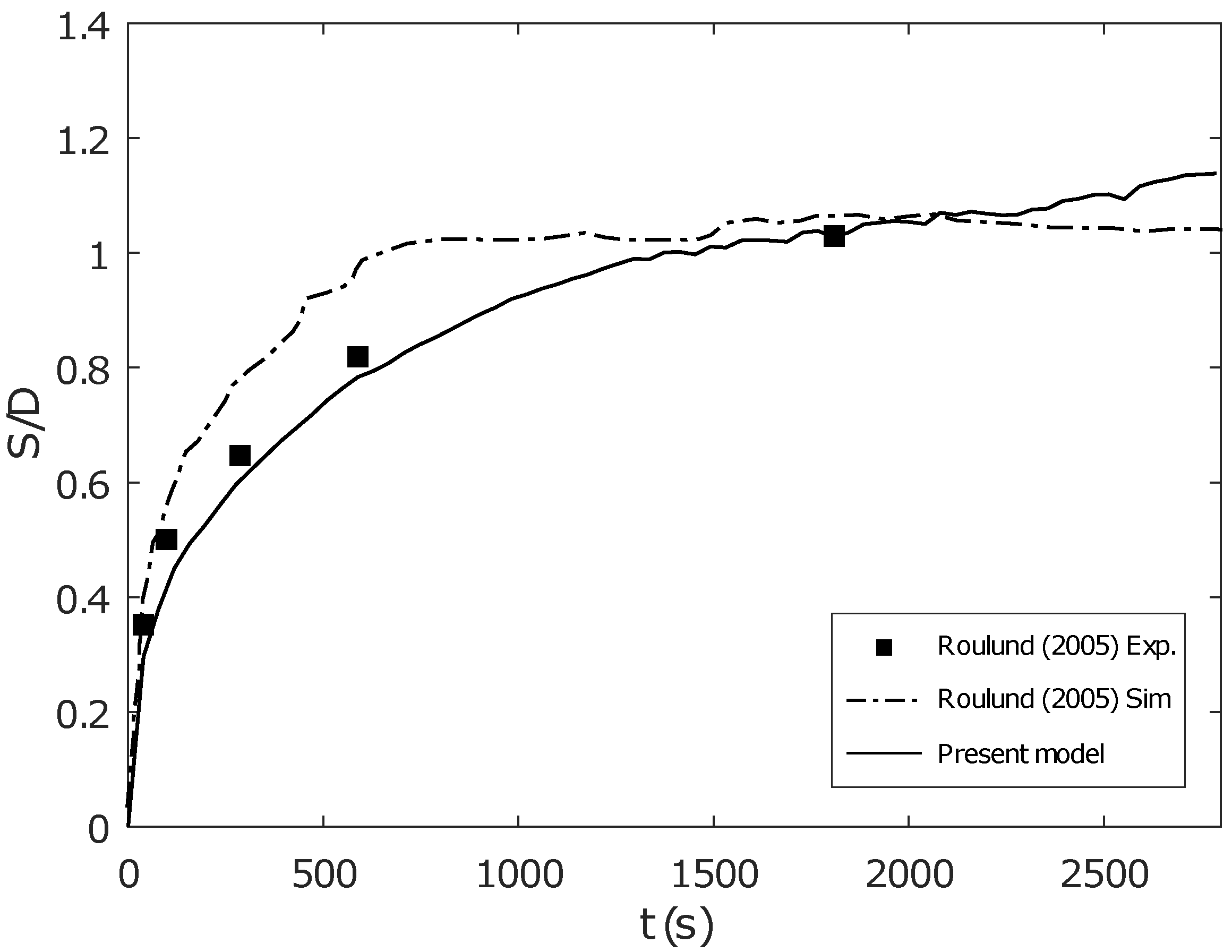
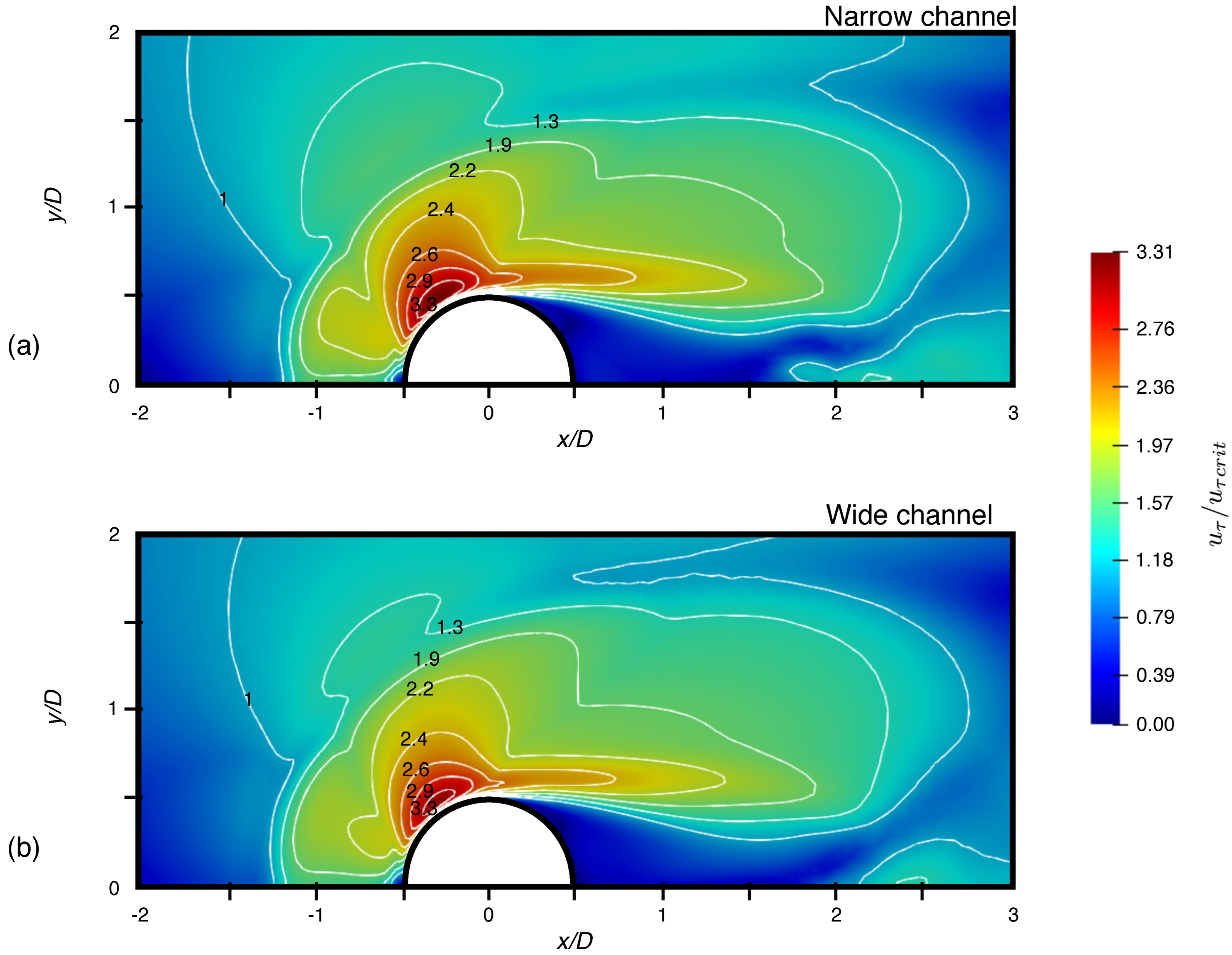
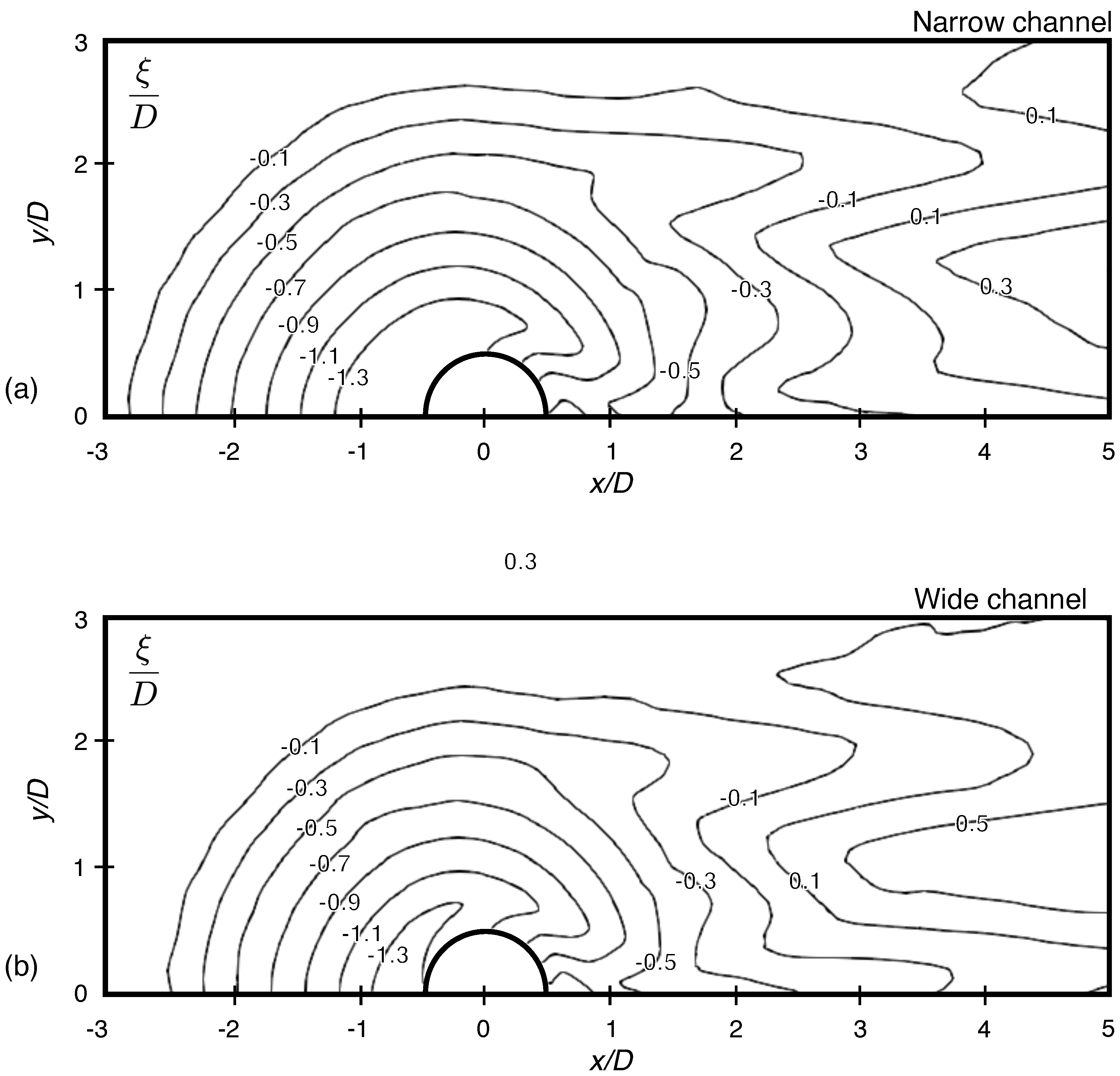

| Reference | Numerical | Turbulence | Sediment Load | Lateral | ||
|---|---|---|---|---|---|---|
| Method | Model | Model | Wall B. C. | |||
| Olsen et al., | FVM | RANS () | Suspended load | 0.2 | Slip | |
| 1993 [26] | (Van Rijn) | |||||
| Zhao et al., | FEM | RANS () | Bedload | 3.9 × 10 | 0.05 | Slip |
| 2010 [27] | (Engelund and Fredsøe) | |||||
| and suspended load | ||||||
| (convection-diffusion) | ||||||
| Khosronejad | UFVM | URANS | Bedload | 2.9–6.3 × 10 | 0.14 | Slip |
| et al., 2012 [28] | (Van Rijn) | |||||
| Link et al., | FVM | DES | Bedload | 3.25 × 10 | 0.07 | Slip |
| 2012 [29] | (Lagrangian model) | |||||
| Bento et al., | FDM | RANS () | Suspended load | 3.5 × 10 | 0.027–0.055 | Non-slip |
| 2023 [36] | ||||||
| Present study | UFVM | LES | Bedload | 1.9 × 10 | 0.1 | Non-slip |
| (Engelund and Fredsøe) |
| Parameter | Symbol | Clear-Water Case | Live-Bed Case |
|---|---|---|---|
| Mean velocity | U | 19.23 cm/s | 46 cm/s |
| Reynolds number | 1923 | 46,000 | |
| Friction velocity | cm/s | cm/s | |
| Water depth | H | 16 cm | 40 cm |
| Cylinder diameter | D | 1 cm | 10 cm |
| Sediment density | 2500 kg m | 2500 kg m | |
| Fluid density | 1000 kg m | 1000 kg m | |
| Grain size | d | mm | mm |
| Sand roughness | m | m | |
| Friction Reynolds number | 6 | 12 | |
| Bed porosity | 0.4 | 0.4 | |
| Critical Shields number | 0.04 | 0.04 | |
| Dynamic friction coefficient | 0.62 | 0.62 | |
| Static friction coefficient | 0.63 | 0.63 |
Disclaimer/Publisher’s Note: The statements, opinions and data contained in all publications are solely those of the individual author(s) and contributor(s) and not of MDPI and/or the editor(s). MDPI and/or the editor(s) disclaim responsibility for any injury to people or property resulting from any ideas, methods, instructions or products referred to in the content. |
© 2023 by the authors. Licensee MDPI, Basel, Switzerland. This article is an open access article distributed under the terms and conditions of the Creative Commons Attribution (CC BY) license (https://creativecommons.org/licenses/by/4.0/).
Share and Cite
Hurtado-Herrera, M.; Zhang, W.; Hammouti, A.; Pham Van Bang, D.; Nguyen, K.D. Numerical Study of the Flow and Blockage Ratio of Cylindrical Pier Local Scour. Appl. Sci. 2023, 13, 11501. https://doi.org/10.3390/app132011501
Hurtado-Herrera M, Zhang W, Hammouti A, Pham Van Bang D, Nguyen KD. Numerical Study of the Flow and Blockage Ratio of Cylindrical Pier Local Scour. Applied Sciences. 2023; 13(20):11501. https://doi.org/10.3390/app132011501
Chicago/Turabian StyleHurtado-Herrera, Mario, Wei Zhang, Abdelkader Hammouti, Damien Pham Van Bang, and Kim Dan Nguyen. 2023. "Numerical Study of the Flow and Blockage Ratio of Cylindrical Pier Local Scour" Applied Sciences 13, no. 20: 11501. https://doi.org/10.3390/app132011501
APA StyleHurtado-Herrera, M., Zhang, W., Hammouti, A., Pham Van Bang, D., & Nguyen, K. D. (2023). Numerical Study of the Flow and Blockage Ratio of Cylindrical Pier Local Scour. Applied Sciences, 13(20), 11501. https://doi.org/10.3390/app132011501










